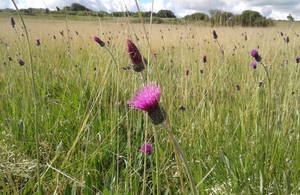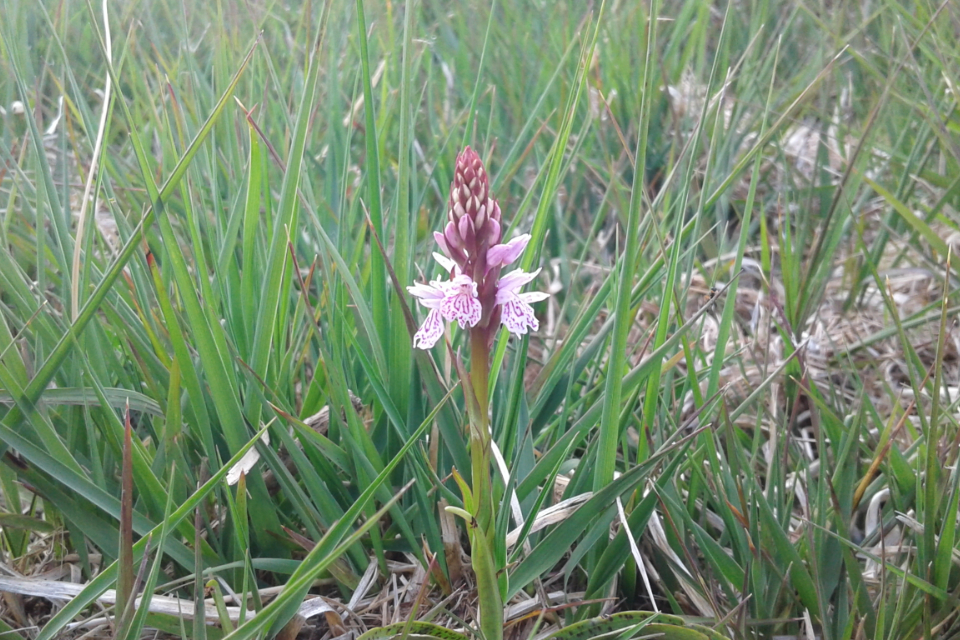Rare butterflies and orchids on abandoned wildlife site boosted by Natural England funding
Common Moor SSSI is officially brought into a recovering condition, following improved site management for the rare Culm grassland.

Wildflower thistle at Common Moor SSSI. Credit: Tom Parsons
Rare species including the marsh fritillary butterfly, lesser butterfly orchids and Cladonia lichen communities have been given a boost as their home in Common Moor Site of Special Scientific Interest (SSSI), Devon, is improved through funding from Natural England.
Following more than a decade of decline - which saw scrub encroach on the rare delicate grassland - a partnership between Natural England, Putford Parish Council, and Devon Wildlife Trust (DWT) has today brought the site back into ‘unfavourable recovering’ condition through Countryside Stewardship (CS) funding. This condition means that the necessary management is now in place for the site to reach favourable condition.
Common Moor SSSI, spanning 55 hectares or more than 60 football pitches, is centrally situated within an arc of six other SSSIs in the North Devonshire countryside, and holds a vital role in connecting green corridors of habitat that allow threatened species to move between locations.
The site is home to an array of rare wildlife – including the charismatic and colourful marsh fritillary butterfly – once widespread in Britain but now threatened across the UK and Europe.
Wesley Smyth, Natural England’s Area Manager for South West, said:
Common Moor is a fantastic example of the difference that Countryside Stewardship can make to help secure the future of rare plants and animals.
Strong partnership working between Natural England, the Devon Wildlife Trust and the Parish Council has brought the SSSI back into a recovering position, with more investment and support to come.
This is a celebration of our partners’ commitment to nature conservation, and a springboard to future successes for the area.
Robert Dixon, Natural England’s Lead Adviser for North Devon Land Team, said:
Having worked on Common Moor for several years, I am delighted to see the vast transformation that is occurring on this ownerless site.
I am especially impressed at the three-way partnership which has enabled this to take place. Without any one of these partners, the project would not have commenced. However, it is the Parish Council that must take the highest credit for these achievements as entering into such an agreement is not commonplace for such a small council.
The team effort of all partners involved has improved the quality of this rare Culm grassland, resulting in improved biodiversity and a better place for locals to enjoy.

Heath spotted orchid flowering at Common Moor. Credit: Tom Parsons
Careful management of Common Moor has resulted in huge improvements to this rare grassland. Current management tools include creating a network of firebreaks over the site and swaling (a method of controlled rotational burning). The management has allowed the growth of fresh vegetation by clearing the ground of overly dominant species and dead material which can swamp more fragile species which rare wildlife rely upon.
Lisa Schneidau, Northern Devon Nature Improvement Area Manager for Devon Wildlife Trust, said:
Devon Wildlife Trust has always seen Common Moor as a very important site.
We are delighted that Putford’s local community have taken on responsibility for this ownerless common land. The new CS agreement means that funding will now be available for the Parish Council to carry out essential management work to maintain the valuable Culm grassland as a haven for wildlife.
The support provided by Natural England throughout has been invaluable, and we look forward to continuing to work alongside both Natural England and the Parish Council on this beautiful site.
This effective three-way partnership will continue in the coming years, with the Parish Council expected to take on management of the site later this year.
Councillor Myles Thomas from Putford Parish Council said:
The Parish Council has wanted to protect Common Moor for many years but have not had the resources to do so.
We are very grateful to Devon Wildlife Trust and Natural England for their help and support in setting up this Countryside Stewardship agreement to stop further deterioration and improve the status of the moor.
This will bring wider benefits to the parish and we are very much looking forward to seeing the changes in wildlife over the coming years.
The 10-year Countryside Stewardship agreement will see further funding and management, securing the long-term future of the site.
Today’s announcement secures an important contribution to the government’s target as set out in the English Biodiversity 2020 Strategy to maintain 95% of SSSIs at favourable or recovering condition.
2019 marks the UK Government’s Year of Green Action, a year-long drive to help people to connect with, protect and enhance nature. The Year was a commitment in Defra’s 25 Year Environment Plan to put people at the heart of nature by working closely with others and developing shared objectives at a landscape-scale.
Additional information
- Common Moor was designated a SSSI in 1988 for being one of a few remnant sites for a type of wet heathland restricted to North Devon and Pembrokeshire. The site also supports a diverse invertebrate fauna.
- The marsh fritillary butterfly is listed on the IUCN Red List as a vulnerable species with a high conservation priority. Marsh fritillary populations are highly volatile and the species requires extensive habitat networks for its long term survival. More information can be found here.
- The lesser butterfly orchid is classified as ‘vulnerable’ and is included as a species “of principal importance for the purpose of conserving biodiversity” under Sections 41 (England) and 42 (Wales) of the Natural Environment and Rural Communities Act 2006. More information can be found here.
- ‘Culm grassland’ is the name given to a distinctive suite of semi-natural, predominantly wet, vegetation communities that occur on the poorly drained acid soils of the Culm measures (Carboniferous shales and sandstones) of North-East Cornwall and North-West Devon. It is in fact a slight misnomer since the main vegetation communities include wet heath, purple moor-grass and rush pasture, fen meadow, mire and scrub, which often occur together in intimate mosaics. The Culm grassland has resulted from the combination of an oceanic climate, poorly draining, acid soils and a long history of management as pasture. It supports an outstanding assemblage of plants and animals, including a number of rare species, such as the marsh fritillary butterfly Euphydryas aurinia.
About Natural England
Natural England is the government’s adviser for the natural environment in England, helping to protect England’s nature and landscapes for people to enjoy and for the services they provide.
Within England, Natural England is responsible for:
- Promoting nature conservation and protecting biodiversity
- Conserving and enhancing the landscape
- Securing the provision and improvement of facilities for the study, understanding and enjoyment of the natural environment
- Promoting access to the countryside and open spaces and encouraging open-air recreation
- Contributing in other ways to social and economic well-being through management of the natural environment
- Follow us on Twitter @naturalengland and visit online at the Natural England website